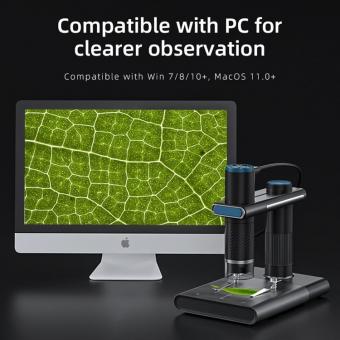Are Viruses Visible Under A Microscope ?
Yes, viruses are visible under a microscope. However, they are much smaller than bacteria and other microorganisms, so they require a high-powered microscope, such as an electron microscope, to be observed.
1、 Viral Morphology: Diverse shapes and structures of viruses.
Viruses are not visible under a standard light microscope due to their extremely small size. They typically range in size from 20 to 300 nanometers, which is significantly smaller than the resolution limit of light microscopes. However, with the advent of electron microscopy, scientists have been able to visualize viruses and study their morphology in detail.
Electron microscopy allows for much higher magnification and resolution than light microscopy, making it possible to observe the intricate structures of viruses. Through electron microscopy, scientists have discovered that viruses exhibit diverse shapes and structures. Some viruses are spherical or icosahedral, resembling tiny soccer balls, while others have helical or filamentous shapes. Some viruses even have complex structures with multiple layers or spikes protruding from their surface.
The latest point of view on viral morphology is that it is incredibly diverse and continues to surprise researchers. Advances in cryo-electron microscopy have allowed scientists to capture high-resolution images of viruses in their native state, providing even more detailed insights into their structures. This technique involves freezing the virus in a thin layer of ice, which preserves its natural shape and allows for imaging at near-atomic resolution.
Understanding viral morphology is crucial for various aspects of virology, including vaccine development, antiviral drug design, and the study of viral evolution. By visualizing and characterizing the structures of viruses, scientists can gain insights into their mechanisms of infection, replication, and interaction with host cells. This knowledge is essential for developing effective strategies to combat viral diseases and protect public health.

2、 Viral Size: Range of sizes exhibited by different viruses.
Viruses are microscopic infectious agents that can cause a wide range of diseases in humans, animals, and plants. When it comes to their visibility under a microscope, the answer is both yes and no.
In general, viruses are too small to be directly observed using a light microscope, which is commonly used in laboratories and schools. Light microscopes have a limited resolution, typically around 200 nanometers (nm), which is larger than most viruses. Therefore, viruses cannot be seen directly using this type of microscope.
However, viruses can be visualized using more advanced microscopy techniques such as electron microscopy. Electron microscopes use a beam of electrons instead of light, allowing for much higher resolution imaging. With electron microscopy, viruses can be magnified up to several hundred thousand times, making them visible.
It is important to note that not all viruses are the same size. Viral size can vary significantly depending on the type of virus. Some viruses, such as the influenza virus, are relatively larger and can be around 80-120 nm in diameter. On the other hand, some viruses, like the poliovirus, are much smaller, measuring only about 22-30 nm in diameter.
It is worth mentioning that recent advancements in microscopy techniques, such as cryo-electron microscopy, have revolutionized our understanding of viruses. This technique allows for the visualization of viruses in their native state, providing detailed information about their structure and function. Cryo-electron microscopy has been instrumental in the development of vaccines and antiviral drugs, as it enables scientists to study the virus-host interactions at a molecular level.
In conclusion, while viruses are not visible under a light microscope, they can be observed using more advanced techniques such as electron microscopy. The size of viruses can vary greatly, and recent advancements in microscopy have greatly contributed to our understanding of these infectious agents.

3、 Viral Staining: Techniques to enhance visibility of viruses under a microscope.
Viruses are not visible under a regular light microscope due to their small size. They are much smaller than bacteria and most other microorganisms, ranging in size from about 20 to 300 nanometers. This makes them too small to be resolved by the lenses of a light microscope, which typically have a maximum resolution of around 200 nanometers.
However, there are techniques available to enhance the visibility of viruses under a microscope. One such technique is viral staining, which involves using dyes or fluorescent markers to selectively bind to the viruses, making them more visible. This technique can help researchers identify and study different types of viruses.
Viral staining techniques have been used for many years to study viruses in various fields, including virology, pathology, and epidemiology. These techniques have provided valuable insights into the structure, behavior, and replication of viruses.
In recent years, advancements in microscopy technology have allowed for even greater visualization of viruses. Electron microscopy, for example, can provide extremely high-resolution images of viruses, allowing researchers to see their intricate structures in detail. Cryo-electron microscopy, a technique that involves freezing samples to preserve their natural state, has also revolutionized virus imaging, enabling the visualization of viruses in their native environment.
It is important to note that while viral staining and advanced microscopy techniques have greatly improved our ability to visualize viruses, they still have limitations. Some viruses may be difficult to stain or may require specific conditions for visualization. Additionally, the resolution of even the most advanced microscopes is still limited by the physical properties of light. Nonetheless, these techniques continue to play a crucial role in our understanding of viruses and their impact on human health.

4、 Electron Microscopy: High-resolution imaging of viruses using electron microscopes.
Viruses are not visible under a light microscope due to their small size, typically ranging from 20 to 300 nanometers in diameter. However, they can be visualized using electron microscopy, which provides high-resolution imaging capabilities.
Electron microscopy involves the use of a beam of electrons instead of light to magnify the specimen. This technique allows for much higher magnification and resolution, enabling scientists to observe the intricate details of viruses. By using electron microscopes, researchers can study the structure, morphology, and behavior of viruses in great detail.
In recent years, advancements in electron microscopy have further enhanced our understanding of viruses. Cryo-electron microscopy (cryo-EM) has emerged as a powerful technique for studying viruses. It involves freezing the virus in a thin layer of ice and imaging it at extremely low temperatures. Cryo-EM has revolutionized the field by enabling the visualization of viruses in their native state, without the need for staining or fixation.
Moreover, the development of advanced detectors and computational algorithms has significantly improved the resolution of electron microscopy. This has allowed scientists to obtain atomic-level details of viral structures, leading to breakthroughs in antiviral drug development and vaccine design.
It is important to note that electron microscopy has its limitations. The sample preparation process can introduce artifacts, and the imaging process itself can be time-consuming and technically challenging. However, with ongoing advancements in technology and methodology, electron microscopy continues to be an invaluable tool for studying viruses and advancing our knowledge of their biology.






































